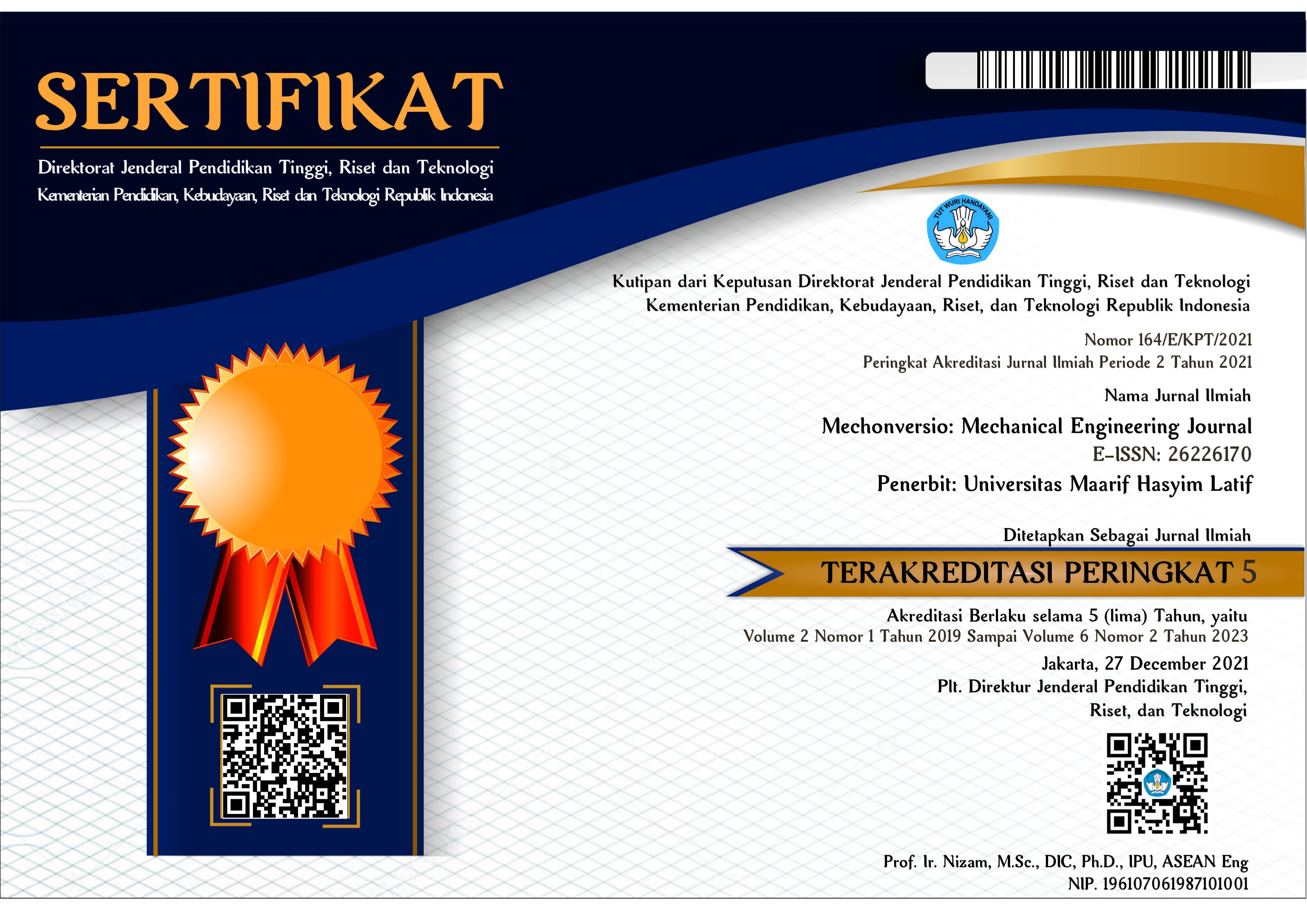ANALISIS PARAMETER CNC TURNING MENGGUNAKAN METODE OPERASI BARIS ELEMENTER PADA SOFTWARE MATLAB TERHADAP KUALITAS SHAFT MATERIAL ALUMINIUM DENGAN INSERT TOOL CARBIDE
DOI:
https://doi.org/10.51804/mmej.v7i1.16632Keywords:
Aluminium , CNC, MATLAB, Operasi Baris ElementerAbstract
Proses pemesinan CNC merupakan fondasi utama manufaktur modern yang penting untuk produksi komponen dengan spesifikasi dan kualitas tinggi. Adapun, parameter pemesinan seperti kecepatan spindel, arah pemotongan, dan kondisi alat pemotong sangat mempengaruhi kualitas produk, termasuk kekasaran permukaan dan integritas struktural. Penelitian ini bertujuan untuk mengoptimalkan parameter pemesinan pada mesin CNC turning dengan bahan aluminium 6061-T6 menggunakan insert tool carbide, guna meningkatkan kualitas permukaan shaft dan umur alat. Sebagaimana diketahui, pendekatan yang digunakan adalah operasi baris elementer pada perangkat lunak MATLAB untuk memecahkan dan mengevaluasi sistem persamaan non-linear. Di samping itu, penelitian dilakukan pada mesin CNC Turning jenis Haas ST-20 dengan variasi parameter kecepatan potong (V), kedalaman potong (d), dan laju pemakanan (f). Material yang digunakan adalah aluminium 6061-T6 dengan insert tool dari Sandvik Coromant model CNMG 432. Hasil penelitian menunjukkan hubungan positif linear antara kecepatan potong, kedalaman potong, dan laju pemakanan terhadap kualitas permukaan. Begitu juga, kecepatan potong optimal adalah 145.00, kedalaman potong optimal adalah 0.72, dan laju pemakanan optimal adalah 0.32, menghasilkan kualitas produk sebesar 90.31. Pada titik ini, temuan ini memberikan kontribusi signifikan bagi industri manufaktur dalam meningkatkan efisiensi dan efektivitas proses pemesinan.
References
Abdulaali, H. H., Abdul Ahleem, S. M., & Kadhim, A. K. J. (2022). The Effect of Machining Parameters on the Temperature Distribution in Metal Cutting Operation. International Journal of Heat and Technology, 40(5), 1234–1240. https://doi.org/10.18280/ijht.400515
Abougarair, A. J., & Tabet, M. A. (2023). Practical work for exploring the capabilities and benefits of CNC technology. 9(2), 55–60. https://doi.org/10.15406/iratj.2023.09.00264
AKGÜN, M., & ÖZLÜ, B. (2022). Optimization of Cutting Parameters Affecting Cutting Force and Surface Roughness in Machining of AISI P20 Die Steel. Open Journal of Nano, 7(1), 31–40. https://doi.org/10.56171/ojn.1039567
Akhtar, M. N., Sathis, T., Mohanavel, V., Afzal, A., Arul, K., Ravichandran, M., Rahim, I. A., Alhady, S. S. N., Bakar, E. A., & Saleh, B. (2021). Optimization of process parameters in cnc turning of aluminum 7075 alloy using l27 array-based taguchi method. Materials, 14(16). https://doi.org/10.3390/ma14164470
Arifin, A., Tama, I., & Sumantri, Y. (2023). Analysis the Effectiveness of Cnc Turning Machines Type Xtra 420 Using the Overall Equipment Method Effectiveness (Oee). Journal of Engineering and Management in Industrial System, 11(1), 46–53. https://doi.org/10.21776/ub.jemis.2023.011.01.5
Bommisetty, S. R., Chettu, K. B., & Hanumanthappa, S. N. (2022). Study and Experimental Investigation of the Effect of Progressive Feed Rate on Surface Roughness in CNC End Milling Process Using RSM. Journal Européen Des Systèmes Automatisés, 55(5), 581–591. https://doi.org/10.18280/jesa.550503
Caijun, L. (2023). Analysis of CNC machine tool self-circulating hydraulic balance system. 6(6), 39–44. https://doi.org/10.25236/AJETS.2023.060606
Djouadi, H., Ouari, K., Belkhier, Y., Lehouche, H., Ibaouene, C., Bajaj, M., AboRas, K. M., Khan, B., & Kamel, S. (2023). Non-linear multivariable permanent magnet synchronous machine control: A robust non-linear generalized predictive controller approach. IET Control Theory and Applications, 17(12), 1688–1702. https://doi.org/10.1049/cth2.12509
Equbal, A., Equbal, M. A., Equbal, M. I., Ravindrannair, P., Khan, Z. A., Badruddin, I. A., Kamangar, S., Tirth, V., Javed, S., & Kittur, M. I. (2022). Evaluating CNC Milling Performance for Machining AISI 316 Stainless Steel with Carbide Cutting Tool Insert. Materials, 15(22), 1–15. https://doi.org/10.3390/ma15228051
Geovanni, D., Alfredo, R., Zamudio-ram, I., Armando, I., Trejo-hern, M., & Antonino-daviu, J. A. (2023). Methodology for Tool Wear Detection in CNC Machines Based on Fusion Flux Current of Motor and Image Workpieces.
Ghosh, T., & Martinsen, K. (2020). NSGA III for CNC End Milling Process Optimization. Communications in Computer and Information Science, 1203 CCIS, 185–195. https://doi.org/10.1007/978-981-15-4301-2_16
Ghosh, T., Wang, Y., Martinsen, K., & Wang, K. (2020). A surrogate-assisted optimization approach for multi-response end milling of aluminum alloy AA3105. International Journal of Advanced Manufacturing Technology, 111(9–10), 2419–2439. https://doi.org/10.1007/s00170-020-06209-6
Habiby, M. N. A., Istianto, uspo V., & Fahmi, M. (2023). Optimization Of Cutting Direction Parameters For A Cnc Milling Machining Process Pocket On Structure And Surface Roughness On Postep Motorcycle Spare Parts. 135–143. https://doi.org/10.21776/MECHTA.2023.004.02.3
Korotkov, V. G. (2023). The modeling of elastic deformations by the cnc machine technological system. 1(42), 34–39. https://doi.org/10.31319/2519-2884.42.2023.4
Liu, H., Wang, Y., & Dong, J. (2022). Application of combined optimization strategy and system of CNC machining parameter. Advances in Mechanical Engineering, 14(7), 1–11. https://doi.org/10.1177/16878132221110004
Lyubich, V. K., Kurmashev, A. D., & Frolov, V. Y. (2021). Synthesis of the CNC machine control algorithms optimized with respect to the contour error using the genetic algorithm. Journal of Physics: Conference Series, 1753(1). https://doi.org/10.1088/1742-6596/1753/1/012027
Pothys, P., Selvam, R., & Kumar, A. S. (2018). Evaluation of Optimal Machining Parameters for Turning by Using Genetic Algorithm. 6(07), 1–5.
Vilor Zakovorotny, L., & Valery Gvindjiliya, E. (2022). Process control synergetics for metal-cutting machines. Journal of Vibroengineering, 24(1), 177–189. https://doi.org/10.21595/jve.2021.22087
Zhang, L. (2022). Application of programmable logic control in the nonlinear machine automation control using numerical control technology. Nonlinear Engineering, 11(1), 428–436. https://doi.org/10.1515/nleng-2022-0229
Downloads
Published
Issue
Section
License
Copyright (c) 2024 Mechonversio: Mechanical Engineering Journal

This work is licensed under a Creative Commons Attribution-ShareAlike 4.0 International License.
With the receipt of the article by MMEJ Editorial Board and the decision to be published, the copyright regarding the article will be transferred to MMEJ. The copyright transfer form can be downloaded here.
MMEJ has the right to multiply and distribute the article and every author is not allowed to publish the same article that was published in this journal.
MMEJ is licensed under a Creative Commons Attribution-ShareAlike 4.0 International License.
Under the following terms:
Attribution — You must give appropriate credit, provide a link to the license, and indicate if changes were made. You may do so in any reasonable manner, but not in any way that suggests the licensor endorses you or your use.
ShareAlike — If you remix, transform, or build upon the material, you must distribute your contributions under the same license as the original.




